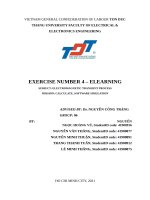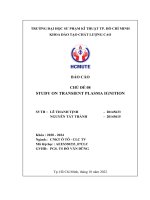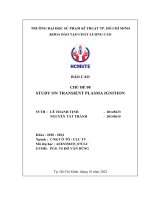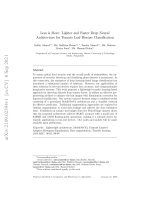Ch05 more SDOF transient
Bạn đang xem bản rút gọn của tài liệu. Xem và tải ngay bản đầy đủ của tài liệu tại đây (587.72 KB, 53 trang )
5
More SDOF—transient
response and approximate
methods
5.1 Introduction
The harmonic excitation considered so far is a special kind of deterministic
dynamic loading that only in a few cases can approximate a real situation.
Nevertheless, its consideration is a necessary prerequisite for any further analysis,
and not only for didactical purposes. If we remember that for linear systems
the principle of superposition holds, from the fact that any reasonably wellbehaved excitation function can be written as the sum or integral of a series of
simple functions, it follows that the total response is then the sum (or integral)
of the individual responses. So, in principle, the complications seem to be more
of a mathematical nature rather than a physical nature, and such a statement
of the problem does not seem to add anything substantial to the understanding
of the behaviour of a linear SDOF system under the action of a complex exciting
load. However, things are not so simple; a number of different approaches and
techniques are available to deal with this problem and the choice is partly a
subjective matter and partly dictated by the complexity of the situation, the
final results that one wants to achieve and the mathematical tractability of the
calculations by means of analytical or computer-based methods.
The first and main distinction can be made between:
•
•
time-domain techniques
frequency-domain techniques.
As the name itself implies, the first approach relies on the manipulation of
the functions involved (generally the loading and the response functions) in
the domain of time as the independent variable of interest. The important
concepts are ultimately the impulse response function and the convolution,
or Duhamel’s, integral.
On the other hand, the second technique is based on the powerful tool of
mathematical transforms: the manipulations are made in the domain of an
appropriate independent variable (frequency, for example, hence the name)
and then, if necessary, the result is transformed back to the domain of the
original variable.
Copyright © 2003 Taylor & Francis Group LLC
The two approaches, as one might expect, are strictly connected and the
result does not depend on the particular technique adopted for the problem at
hand. Unfortunately, except for simple cases, both techniques involve evaluations
of integrals that are not always easy to solve and their practical application
must often rely heavily on numerical methods which, in their turn, require the
relevant functions to be ‘sampled’ at regular intervals of the independent variable.
This ‘sampling’ procedure introduces further complications that belong to the
specific field of digital signal analysis, but they cannot be ignored when
measurements are taken and computations via electronic instrumentation are
performed. Their basic aspects will be dealt in future chapters.
Until a few decades ago the computations involved in frequency-domain
techniques were no less than those in a direct evaluation of the discrete
convolution in the time domain. The development of a special algorithm
called the fast Fourier transform [1] has completely changed this situation,
cutting down computational time of orders of magnitude and making
frequency techniques more effective.
Both the convolution integral and the transform methods apply when
linearity holds; for nonlinear systems recourse must be made to a direct
numerical integration of the equations of motion, a technique which,
obviously, applies to linear systems as well.
When the predominant frequency of vibration is the most important
parameter and the system is relatively complex, the Rayleigh ‘energy method’
and other techniques with a similar approach turn out to be useful to obtain
such a parameter. The simplest application represents a multiple- (or infinite-)
degree-of-freedom system as a ‘generalized’ SDOF system after an educated
guess of the vibration pattern has been made. The method is approximate (but
so are numerical methods, and in general are much more time consuming) and
its accuracy depends on how well the estimated vibration pattern matches the
true one. Its utility lies in the fact that even a crude but reasonable guess often
results in a frequency estimate which is good enough for most practical purposes.
5.2 Time domain—impulse response, step response and
convolution integral
Let us refer back to Fig. 4.7. The SDOF system considered so far is a particular
case of the situation that this figure illustrates, i.e. a single-input single-output
linear system where the output x(t) and the input f(t) (written as a force for
simplicity, but it need not necessarily be so) are related through a linear
differential equation of the general form
(5.1)
Copyright © 2003 Taylor & Francis Group LLC
The coefficients ai and bj (i=1, 2, 3, ···, n; j=1, 2, 3, ···, r), that is the parameters
of the problem, may also be functions of time, but in general we shall consider
only cases when they are constants. On physical grounds, this assumption
means that the system’s parameters (mass, stiffness and damping) do not
change, or change very slowly, during the time of occurrence of the vibration
phenomenon. This is the case, for example, for our spring—mass-damper
SDOF system whose equation of motion is eq (4.13), which is just a particular
case of eq (5.1).
Very common sources of excitation are transient phenomena and
mechanical shocks, both of which are obviously nonperiodic and are
characterized by an energy release of short duration and sudden occurrence.
Broadly speaking, we can define a mechanical shock as a transmission of
energy to a system which takes place in a short time compared with the
natural period of oscillation of the system, while transient phenomena may
last for several periods of vibration of the system.
An impulse disturbance, or shock loading, may be for example a ‘hammer
blow’: a force of large magnitude which acts for a very short time.
Mathematically, the Dirac delta function (Chapter 2) can be used to represent
such a disturbance as
(5.2)
where has the dimensions newton-seconds and describes an impulse (time
integral of the force) of magnitude
(5.3)
One generally speaks of unit impulse when
From Newton’s second law fdt=mdv, assuming the system at rest before
the application of the impulse, the result on our system will be a sudden
change in velocity equal to
without an appreciable change in its
displacement. Physically, it is the same as applying to the free system the
initial conditions x(0)=0 and
The response can thus be written
(eq (4.8))
(5.4)
for an undamped system, and (eq (4.27))
(5.5)
Copyright © 2003 Taylor & Francis Group LLC
for a damped system. In both cases it is convenient to write the response as
(5.6)
where h(t) is called the unit impulse response (some authors also call it the
weighting function) and is given by
(5.7a)
for the undamped and damped case, respectively. Equations (5.7a) represent
the response to an impulse applied at time t=0; if the impulse is applied at
time
they become
(5.7b)
for
and zero for
since the change of variable from t to is
geometrically a simple translation of the coordinate axes to the right by an
amount
seconds. In practice, an impact of duration ∆t of the order of
10–3 s (and ∆ t is short compared to the system’s period)
is a
common occurrence in vibration testing of structures. In these cases, the
considerations above apply.
Figure 5.1 illustrates a graph of
for a damped system with unit
mass, damping ratio
and damped natural frequency
Example 5.1. Let us consider the response of an undamped system to an
impulse of a constant force f0 that acts for the short (compared to the system’s
period) interval of time 0
(5.8)
Copyright © 2003 Taylor & Francis Group LLC
Fig. 5.1 Impulse response function h(t)—damped system.
During the ‘forced vibration era’ (0
by f 0 /k, i.e.
(5.9)
the initial conditions x(0)=0 and
and we get
(0)=0 determine the constants A and B
(5.10)
In the ‘free vibration era’ (t>t1)the excitation is no longer active and the
response is given by eq (4.8) with initial conditions determined by the state
of the system at the instant t=t1. Explicitly this is written
(5.11)
Copyright © 2003 Taylor & Francis Group LLC
where
(5.12)
and the approximations above hold for
(or, better,
that
and that the impulse has a value
obtain in the limit
). By noting
from eq (5.11) we
(5.13)
which is, as expected, the impulse response of the undamped system (eq
(5.4)). It is left to the reader to determine how considerations similar to the
ones above lead to eq (5.5) for a damped system.
A general transient loading such as the one shown in Fig. 5.2 can be
regarded as a superposition of impulses; each impulse is applied at time
and has a magnitude given by f( )∆ , with varying along the time axis
(shaded area in Fig. 5.2).
Mathematically we can write
(5.14)
and the function f(t) can be approximated by a superposition of these
impulses as
(5.15)
Fig. 5.2 General loading as a series of impulses.
Copyright © 2003 Taylor & Francis Group LLC
The response to the impulse of eq (5.14) is
and the total response from time
to time
is obtained by summing
the effects of all the impulses up to the instant t, i.e.
(5.16)
Passing to the limit of
response from
to
the summation becomes an integral and the
is finally given by
(5.17)
The integral of eq (5.17) is known as Duhamel’s integral or convolution
integral and may be used to determine the response to an arbitrary input as
long as it satisfies certain mathematical conditions. For our damped SDOF
system the explicit expression of eq (5.17) is given by
(5.18)
if the system is initially at rest. If this is not the case, the complementary
function must be added, thus obtaining
(5.19)
It should be noted that all linear systems can be completely characterized by
their impulse response function (functions if there is more than one input and
more than one output) and furthermore, the response to any input is given by
the input function’s convolution with the system’s impulse response function.
The importance of these concepts deserves a few comments and observations.
The nature of the convolution integral can be ‘visualized’ by considering
that its evaluation is performed through multiplication of f( ) by each
incremental shift in
. As the present time t varies the impulse response
scans the excitation function, producing a weighted sum of past inputs
up to the present instant; so, in terms of the superposition principle the
system’s response x(t) may be interpreted as being the weighted superposition
Copyright © 2003 Taylor & Francis Group LLC
of past input f( ) values ‘weighted’ or multiplied by
. In other words,
to find the response x(t0) for some t=t 0, we form the function
and we
shift it to
; the area of the product
yields x(t0).
In the foregoing discussion we have assumed that the force f(t) starts at
t=0; since this may not be case and f(t) can extend to negative values of t,
we can write eq (5.17) in the more general form
(5.20)
In order for a constant-parameter linear system to be physically realizable
(causal), it is necessary that it responds only to past inputs; this requires
(5.21)
In fact, if we recall that
is the response to an impulse applied at time
(i.e.
), for
(i.e.
) there is no response because no
impulse has been applied. This justifies eq (5.21) and allows us to extend the
upper limit of integration in eq (5.20) from
without changing
the result; we can then write
(5.22)
We note in passing that a physical system is always causal if the
independent variable is the real time t; however, not all physical systems are
causal (for example, if the independent variable is a space variable).
Consider now, in eq (5.20), the change of variable obtained by defining
where can be interpreted as the time delay between the occurrence
of the input and the instant when its result is calculated; we get
where the minus sign in the second integral comes from the fact that
Changing over the limits of integration to dispense with the minus
sign we get
(5.23)
which is an alternative form of the convolution integral.
Copyright © 2003 Taylor & Francis Group LLC
Another alternative form can be obtained either by putting
in eq
(5.20) or by noting—in the second integral of eq (5.23)—that
for
since there is no response before the impulse occurs: this yields
(5.24)
The equality between the two integrals is obvious and in the last expression
we have used the common symbol * to indicate the convolution between
two functions. Equation (5.24) is the most general form of the convolution
integral for our purposes.
An analogous line of reasoning, starting from eq (5.17) leads to
(5.25)
which, with eq (5.24), shows the symmetry of the convolution integral in
the excitation f(t) and the impulse response h(t). Simplicity suggests that the
simpler of the two functions be shifted in performing the calculations.
A constant-parameter linear system is stable if any possible bounded input
produces a bounded output. Since
(5.26)
if the input is bounded, i.e. there exists some finite constant K such that
(5.27)
then
(5.28)
It follows that if the impulse response function is absolutely integrable, i.e.
(5.29)
then the output will be bounded and the system is stable. Note that x(t) does
not need to satisfy
Copyright © 2003 Taylor & Francis Group LLC
(5.30)
which is necessary in the classical Fourier transform (frequency response)
approach.
A final comment to show the important property of frequency preservation
in linear systems. Let h(t) be the impulse response of a constant-parameter
linear system; for an arbitrary, well behaved input f(t) the nth derivative of
the output x(t) is given by
(5.31)
If we assume a sinusoidal input of the general form
obtain, for example, for its second derivative
this result in eq (5.31) we get
we
Inserting
(5.32)
so that x(t) must be sinusoidal with the same frequency as f (t). It follows
that a constant-parameter linear system cannot cause any frequency
translation, but can only modify the amplitude and phase of an applied
input.
Example 5.2. Let us now determine the response of a damped system to the
step function given by eq (5.33), which is often called the Heaviside function
when f 0 =1. In real situations this could model some kind of machine operation
or a car running over a surface that changes level abruptly (i.e. a curb).
(5.33)
For
assuming that the system starts from rest, the response can be
written as the convolution integral
(5.34)
which can be easily calculated if we remember that
Copyright © 2003 Taylor & Francis Group LLC
Since
and
after some manipulations we get
(5.35)
where in the second expression
(5.36)
It is worth noting how the same result can be obtained by writing (for
the general solution of the equation of motion. This is
)
(5.37)
The initial conditions x(0)=0 and
(0)=0 give for the constants
which, after substitution in eq (5.37) and a little algebra, give exactly the
solution of eq (5.35). Figure 5.3 is a graph of eq (5.35) with: f0=50 N, k=1000
N/m,
and
For an undamped system eq (5.37) becomes
(5.38)
The response to a unit step input (sometimes called indicial response) and
the unit step function (Heaviside) itself are also very important in linear
vibration theory and are often indicated with a symbol of their own: as we
did in Chapter 2, we will write θ (t) for the Heaviside function applied at t=0
while we will use the symbol s(t) for the response to a Heaviside input. We
can write symbolically eq (4.13) for our SDOF linear system as
(5.39)
Copyright © 2003 Taylor & Francis Group LLC
Fig. 5.3 Response to step function.
where D is the linear differential operator
(5.40)
Following this notation, we can then write the symbolic relations
(5.41)
and since—in the sense of distributions (Chapter 2)—it can be shown that
it is left to the reader to determine the following important relations between
the impulse response and the Heaviside response
(5.42)
which can be verified in eqs (5.7a), (5.35) and (5.38) (see also eq (5.34)).
Copyright © 2003 Taylor & Francis Group LLC
Two more examples will now show further applications of what has been
said up to this point. Both examples refer to an undamped SDOF system,
since this system is often considered—for comparison purposes—in the
analysis of shock loading. In these cases, the excitation is short compared to
the natural period of the structure and as a result, the response is not
significantly influenced by the presence of damping. We point out that the
response of structures to shock is vital in design, particularly preliminary
design, to select the system’s parameters in a manner that limits within a
specified range a certain response quantity—e.g. maximum response
amplitude, maximum stress etc.—in order to prevent undesired vibration or
damage of the structure. The concept of shock (or response) spectrum has
been devised to deal with these problems and, due to its importance, it will
be considered separately in the following section.
Example 5.3. The first example is the response to a rectangular pulse of
duration t1 and amplitude f0. This problem has already been considered in
Example 5.1 (eqs (5.10) and (5.11)), but now we proceed from eq (5.11) by
substituting the appropriate initial conditions (5.12) to obtain an explicit
expression for the ‘free vibration era’ t>t 1. The substitution gives
which, after some manipulations, yields the response for t>t1
(5.43)
Alternatively, the rectangular pulse f(t) can be seen as the superposition
of two step functions, i.e.
where f1(t) is given by eq (5.8),
f2(t) is a step of magnitude –f0 applied at t=t 1 and the response can be
determined accordingly as a superposition of the two responses. Needless to
say, the results are again eq (5.10) for the ‘forced vibration era’ and eq (5.43)
for the ‘free vibration era’. The reader is invited to draw a graph of the
response for different values of t1.
Example 5.4. In this second example we consider the response of an
undamped system to a half-sine shock excitation, that is, to an excitation
function of the form
(5.44)
Copyright © 2003 Taylor & Francis Group LLC
During the ‘forced vibration era’
the exciting function is a
sinusoid with circular frequency
In order to calculate the
response, we notice that f(t) can be written in phasor form as
if we
agree to take the imaginary part as described in Chapter 1 (recall that
the form of the exponential and the choice of the real or imaginary part
is a matter of convenience, it is only important to be consistent). The
response is then given by
and the integral can be easily solved using again
where now
and
calculation of the definite integral in brackets yields
The
Taking the imaginary part of the expression above we get the system’s
response for
which is
(5.45)
The response in the ‘free vibration era’ (t>t1) is obtained from eq (4.8)
with initial conditions that are determined by the state of the system at t=t1:
this is
(5.46)
where now
(5.47)
Copyright © 2003 Taylor & Francis Group LLC
Substitution of eqs (5.47) into eq (5.46)—considering that
—yields
(5.48)
Figures 5.4(a) and 5.4(b) illustrate how the same undamped SDOF system
responds to two different half-sine excitations.
Fig. 5.4 Undamped SDOF system—half-sine response. (a)
(b)
Copyright © 2003 Taylor & Francis Group LLC
Both the excitation and the response are shown in the two graphs even if the
measurement units are obviously different (newtons for the excitation function
and metres for the response displacement function).
5.2.1 Shock response
We defined a shock as a sudden application of a force (or other form of
excitation) that results in a transient response of a system. Roughly speaking,
a shock takes place in a short time (t1) compared with the natural period of
the system, i.e. t1/T<1, and the vibration severity that it causes can be
categorized by analysing, as a standard reference, the maximum value of the
response of an undamped SDOF system. The whole time history of the
response is not considered for this purpose, and significance is given to its
maximum value plotted as a function of t1/T or, alternatively, as a function
of ω n /ω when the quantity ω (frequency of the exciting pulse) can be defined.
Such curves, extensively used in engineering practice, are called response
or shock spectra. Several kinds of maxima are important, but in general the
so-called maximax response is considered, which is the maximum of the
response attained at any time following the onset of the shock pulse.
Mathematically speaking, given an exciting force f(t) of duration t1, we
want to determine the quantity
(5.49)
Let us consider a rectangular pulse of amplitude f0 and duration t1. The
response to such excitation is given by eqs (5.10) and (5.43) in the ‘forced’
and ‘free’ vibration era, respectively. The maximum value of response will
be attained in either the first or second era, depending on the value of t1:
when t
provided that
(5.50)
where n is an integer and we have taken n=1 because we are interested in the
first maximum and we know that
Substitution of tm in eq (5.10)
gives the maximum value
Copyright © 2003 Taylor & Francis Group LLC
(5.51)
and this result can be stated by saying that the maximum value of the ratio
of dynamic response to static deformation (maximum dynamic magnification
factor) is equal to 2.
In the free vibration era the response is given by eq (5.43). Equating its
derivative to zero gives the condition
which—considering again the first maximum—is verified at a time tm given by
i.e.
(5.52)
provided that
i.e.
yields after some manipulation
Substitution of eq (5.52) in eq (5.43)
(5.53)
The response spectrum for a rectangular pulse excitation is then obtained
by combining eqs (5.51) and (5.53) and is shown in Fig. 5.5.
We turn now to the half-sine excitation considered in Example 5.4. The
response to this kind of pulse is given by eqs (5.45) and (5.48) for the forced
and free vibration era, respectively and, once again, the maximum value can
be attained for
or t>t1, depending on the value of t1. The two cases
are illustrated in Figs 5.4(a) and 5.4(b).
Let us suppose that the maximum response occurs in the forced vibration
era; equating the derivative of eq (5.45) to zero gives
which is satisfied at a time tm determined by
(5.54)
Copyright © 2003 Taylor & Francis Group LLC
Fig. 5.5 Rectangular pulse—shock spectrum.
The first maximum is attained by considering the minus sign and n=1 in
eq (5.54) and we get
(5.55)
provided that
which means
and hence
(5.45) yields after some manipulation
(or
) if we remember that
Substitution of eq (5.55) in eq
(5.56a)
or, defining
(5.56b)
So, for example, if
it follows
and the maximum value
of the dynamic magnification factor D is given by
Copyright © 2003 Taylor & Francis Group LLC
If the maximum occurs for t>t 1, equating the derivative of eq (5.48) to
zero leads to
which is satisfied at the time tm given by
(5.57a)
(5.57b)
provided that
i.e.
(or)
and we have considered the
first maximum (n=1 and the minus sign) passing from eq (5.57a) to eq (5.57b).
Substitution of the explicit expression for tm in eq (5.48) yields for the
maximum value of displacement
(5.58a)
or, as a function of
(5.58b)
for example, if
the maximum value of D is found to be
The shock spectrum for a half-sine pulse excitation is shown in Fig. 5.6,
where Dmax is plotted as a function of t1/T.
At resonance, i.e. when
(or), the expressions given by
eqs (5.56a or 5.56b) and (5.58a or 5.58b) become indeterminate but the value of
Dmax can be obtained by calculating the limit for
and using L’Hospital’s
rule in either one of the above equations. It is not difficult to show that
Copyright © 2003 Taylor & Francis Group LLC
Fig. 5.6 Half-sine pulse—shock spectrum.
Following a similar line of reasoning, shock spectra for other impulsive
loading conditions can be worked out (e.g. Harris [2], Jacobsen [3]).
The calculations become more and more laborious, especially if damping
is taken into account, and other techniques are available (for example the
Laplace transform, which will be considered later, and the plane-phase or
other graphical methods), but often one has to make use of a computer for
an extensive investigation of the problem.
However, the following general conclusions can be drawn for step-type
and pulse-type excitations, where damping is of relatively less importance
unless the system is highly damped.
The excitation—a function of time only—may be a force applied to the
mass (as in the examples above) or a ground motion acting on the spring
anchorage. The ground motion, in its turn, can be in the form of displacement,
velocity or acceleration. All these cases are mathematically similar and the
general equation
(5.59)
can be used, where v and ξ are the response and the excitation, respectively,
in the appropriate form. For example, if y(t) is the ground displacement with
respect to a fixed frame of reference, the equation of motion is (4.55) with
c=0, i.e.
Copyright © 2003 Taylor & Francis Group LLC
which, differentiating twice with respect to time, can be rearranged to
and can be treated as a second-order equation in
when the ground
acceleration ÿ(t) is given. Note the formal analogy with eq (5.59) where v=
and
For step-type excitations xmax occurs after the step has risen to its full
value (t1 being the rise time) and the extreme values of Dmax are 1 and 2.
As the ratio t1/T approaches zero, Dmax approaches the upper limit of 2;
when t1/T approaches infinity (low rise time compared to the system’s
natural period), the step loses its character of dynamic excitation and Dmax
approaches the lower limit of 1, which means that xmax tends to the static
value f0/k.
The reader is invited to verify that for some shapes of the step rise time,
Dmax is equal to unity at certain finite values of t1/T: for example, for a step
with constant slope rise, Dmax=1 when
Different values
are obtained for different shapes of the slope, but the minimum value of t1/
T for which this occurs is 1. When Dmax=1, the amplitude of motion with
respect to the final value of the excitation as a base (the so-called residual
response) is zero and this fact is sometimes exploited in the practical design
situation in order to achieve the smallest possible residual response.
For pulse-type excitations, when the ratio of pulse duration to system
natural period t1/T is less than 1/2, the shape of certain types of pulses of
equal area (equal impulse) is of secondary significance in determining the
maxima of the system’s response. If
the pulse shape has little
significance in almost all cases; only when
must the pulse shape
be considered carefully. Furthermore, the maximum response usually occurs
for
and Dmax has values between 1.5 and 1.8. If the pulse has
a vertical rise, Dmax attains asymptotically the value of 2 and in the particular
case of rectangular pulse Dmax=2 for
Again, the reader is invited to verify that the residual response amplitude
is zero for certain values of t1/T and if the pulse has a vertical rise or a vertical
decay (but not both) there are no zero values except at
In the case
of a rectangular pulse, the residual response is zero for
As
an example, Fig. 5.7 shows the response of the undamped SDOF to a
rectangular pulse of duration t1=4 s in the case of
Note that Fig. 5.7 illustrates a particular case; for different values of
t1/T the oscillation of the system continues after the end of the pulse with
Copyright © 2003 Taylor & Francis Group LLC
Fig. 5.7 Rectangular pulse response
.
amplitude characteristics that depend on the value of t1/T considered in the
specific case under study.
For several shapes of pulse the minimum value of t1/T for zero residual
response is 1 and occurs for an exciting rectangular pulse; for a sine pulse
the lowest value for zero residual response is
and for a symmetrical
triangular pulse is
5.3
Frequency and s-domains. Fourier and Laplace
transforms
Fourier analysis is a mathematical technique that deals with the addition of
several harmonic oscillations to form a resultant and with the opposite
problem. Any branch of physical sciences in which harmonically varying
quantities play a part makes use of the theory of Fourier analysis at some
stage of its theoretical development. The subject of engineering vibrations is
no exception, and we have already given a review of the fundamental
mathematical aspects in Chapter 2. We move on from there, recalling some
of these fundamentals when needed in the course of our investigation. With
respect to Chapter 2, small differences in notation will be noted in a few
cases. They have been adopted to suit our present needs and, in any case,
are irrelevant to the essence of the discussion as long as consistency is
maintained from the beginning to the end of the specific argument being
discussed.
Copyright © 2003 Taylor & Francis Group LLC
5.3.1 Response to periodic excitation
A periodic signal is a particular type of deterministic (i.e. that can be expressed
by an explicit mathematical relationship) signal that repeats itself in time
every T seconds; T is called the period and for all values of t
where n=1, 2, 3, ···. Provided that the fluctuations in f(t) are not too
pathological, a periodic function can be represented by a convergent series
of harmonic functions whose frequencies are integral multiples of a certain
fundamental frequency
A periodic exciting function f(t) (written in the form of a force for our
present convenience) can be written as
(5.60a)
or, alternatively
(5.60b)
or, in complex notation
(5.60c)
where
establish the relation between eqs (5.60a) and (5.60b), and
give the relation between eq (5.60a) and the complex form.
If all the Cs are real, then all the bs are zero, f(t) is real and an even
function of t, i.e. f(–t)=f(t); if
(i.e. all as and bs are real, as in our
case), then f(t) is real but not necessarily symmetrical about t=0. We point
Copyright © 2003 Taylor & Francis Group LLC
out that eq (5.60c) is not a phasor representation of the input signal (the
second expression of eq (5.60b) is!), it is a different way of writing the periodic
function f(t) in its own right, where no convention of taking only the real or
imaginary part is implied.
The conditions for the convergence of the series are extremely general
and cover the majority of engineering situations; one important restriction
to be kept in mind is that, when f(t) is discontinuous, the series gives the
average value of f(t) at the discontinuity. The Fourier coefficients of the
series are given by (eq (2.6b) or (2.10))
(5.61)
for the expression of eq (5.60a) and
(5.62)
for the complex representation of eq (5.60c).
The mean (over one period) and mean-square values of f(t) and of its time
derivative can be expressed in terms of the Fourier coefficients as (Parseval’s
theorem)
(5.63)
and
(5.64)
Obviously, the periodic function could be a displacement and in this case
eqs (5.64) would give the mean and mean square of velocity.
Copyright © 2003 Taylor & Francis Group LLC
Under such an excitation, we have the equation of motion for our damped
SDOF system
(5.65)
Owing to the principle of superposition, the steady-state response to each
harmonic component can be calculated separately and the results added to
obtain—following the notation of eq (4.40)—the particular solution x2(t).
This is
(5.66)
which can be recognized as a Fourier series itself where
(5.67)
and
Alternatively, if the excitation is written in the more compact form of eq
(5.60c), x2 too can be taken in the form of a series with summation from –
to + . Since we have determined in Chapter 4 (eqs (4.48) and (4.92)) that
the steady-state response of our system to a sinusoidal load
is written
(5.68)
where H(ω0) is the complex frequency response function (receptance in this
case, see also subsequent sections) and is given by
(5.69)
the response to our periodic load can be written as
(5.70)
Copyright © 2003 Taylor & Francis Group LLC









